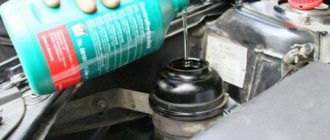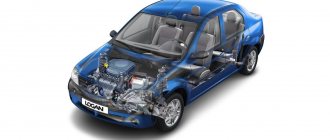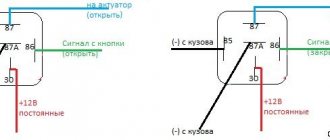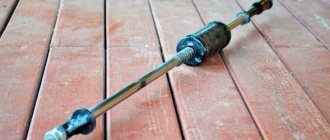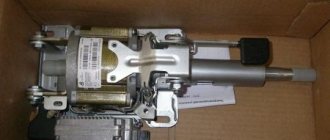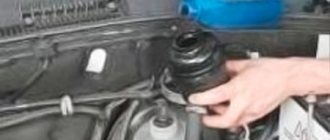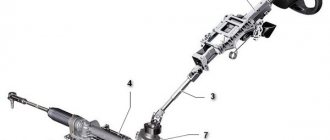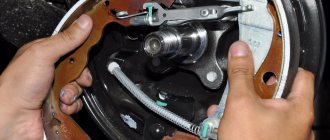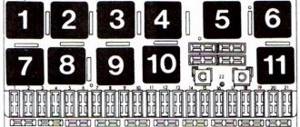Power steering (abbreviation power steering) is familiar to most car enthusiasts. It refers to the main part of the steering mechanism. Previously, driving a car was a very tedious task, since during a sharp change in trajectory you had to strain to turn the steering wheel, this was especially problematic on trucks. Designers, who always improve details for convenience, comfort and safety, paid attention to this, so the steering wheel was no exception. To keep the effort to a minimum, a power steering system was invented.
Its main purpose, as it was intended, is comfortable control of the car while driving, but there are other equally important merits, such as:
- maintaining “feedback”;
- ensuring road stability;
- increased safety. That is, there is control over the vehicle after damage to the front tire and the ability to avoid a collision;
- allows you to “feel” the road surface and creates a kinematic tracking action;
- reduces the steering system gear ratio, which increases maneuverability;
- extends the service life of steering unit parts.
Power steering
The power steering is compact in design and can absorb impacts that vibrate from the road surface to the steering wheel. They are completely silent during use. With their appearance, driving became accident-free, even the number of parking spaces was halved. Having a hydraulic booster in the car, complex turns and multiple maneuvers began to be a success. However, many do not know the principle of operation of the installed standard hydraulic booster, and when the vehicle pulls to the side, they try to resolve the situation with wheel alignment, doing it incorrectly. Naturally, experienced wheel breakers can easily set the wheel alignment angles for the correct “resistance” to the car pulling to the side if the hydraulic booster is faulty.
To ensure that the device does not fail and reliably performs all prescribed tasks, you must promptly visit service centers for diagnostics.
Types of hydraulic boosters
It cannot be said that standard power steering is absolutely necessary. It is only useful in certain moments. Of course, it allows you to successfully maneuver in urban conditions, but on an open highway at high speed it is of no use at all. As your speed increases, you stop “feeling” the road, which is popular especially in winter.
In order to somehow cover the flaw, it was decided to install a steering rack with a variable subordinate ratio. However, the attempt was unsuccessful; the situation was saved by the electronics, which acted as a modification of the hydraulic booster. It combines not only comfort, but also the information content of the steering wheel. The electric power steering (EGPS) serves the same principle; the differences are the addition of an electronic unit and an actuator solenoid valve.
Power steering reservoir
Power steering: design and principle of operation
To understand how the power steering structure works, consider the power steering diagram, consisting of such parts as:
- hydraulic power cylinder is placed in the steering part, where it stands between the drive and body parts. It is connected to a spool control unit and a hydraulic cylinder. The main merit is the conversion of fluid pressure into the movement of a piston and rod, which help move the wheels in the desired direction.
- The pump is attached to the engine and is driven from the crankshaft by a belt drive from the crankshaft pulley. Required to generate oil pressure. Blade-type designs are more common because they have good efficiency.
- The working fluid is contained in the tank, there is also a filter, a lid with a dipstick for measuring the level. The function of oil is to lubricate rubbing parts and transmit force from the pump to the hydraulic cylinder.
- The reservoir is filled with hydraulics and there is a filter inside to keep it clean.
- The pressure regulator or distributor is a precision (highly stable) and simple unit in design. It is a pressure reducing valve. It is located on the steering gear parts or on the same shaft with the steering element. Its task is to distribute hydraulics into the desired cavity of the hydraulic cylinder or back into the tank. Required to control the engine crankshaft speed so that it does not increase the permissible hydraulic fluid pressure. The spool valve is a complex part consisting of a torsion bar and a spool valve. When the spool inside rotates, the distributor is called rotary, and if it moves translationally, it is called axial.
- Connecting hoses high and low pressure are brought together by a hydraulic cylinder, pump and distributor. They also circulate hydraulic fluid from the tank to the pump and back, returning from the distributor. Where it is necessary to create mutual mobility of units, flexible hoses are used.
The operating principle of power steering and power steering is similar
The principle of operation of power steering with both axial and rotary distributors is based on the movement of the spool when the steering wheel is shifted. First, the pump generates pressure in the steering assembly. If the steering wheel is turned to one side, the spool begins to move and closes one of the drain lines, and the working fluid under pressure flows into the necessary cavities of the hydraulic cylinder. Hydraulics with a rod presses on the piston, and it moves the wheels.
When the wheels turn, they point the distributor body in the direction the spool moves. And when the spool becomes immobilized, the distributor body begins to restore its normal position. Oil easily passes from the discharge line into the drain line. Next, the amplifier simply pumps the working fluid through the system using a pump. At the same time, the wheels are pointing straight ahead. When the steering wheel stops turning, the whole pattern changes and stops.
Even if the hydraulic pump breaks down (for example, the drive belt breaks), this does not affect the control of the vehicle. Because the force from the steering system will go to the distributor body, and then to the wheels with the spool. Through the pre-start valve, the hydraulics will move from one cavity to another and not create obstacles, which will allow you to turn the steering wheel only with tension. The power steering diagram clearly demonstrates the essence of the system.
Power steering pump design
When the steering wheel is turned in the other direction, the distributor supplies oil to opposite parts of the hydraulic cylinder; accordingly, the steering rack goes in the other direction and turns the wheels in the desired direction. As for the driver, he makes minimal effort to turn the steering wheel. When the car is not moving, turning the steering wheel also simply requires that the engine be started.
If the vehicle hits an obstacle, the repulsion force tries to turn the wheels. But instead, they move the distributor body relative to the spool and block the drain line. After which the hydraulic fluid enters the cylinder cavity, and the piston sends forces to the wheels moving in the opposite direction. A quick reaction causes the wheels to lock and become unable to turn. Due to the fact that the spool stroke is small (about 1 mm), the vehicle practically does not change the direction of movement. The power steering protects the driver's hands from colliding with the steering wheel spokes when he crashes into something. Small tremors are still felt - this is due to the fact that pressure increases above the jet washers.
“Road feel” is feedback from the steering wheels through the amplifier to the steering wheel. Tells the driver under what conditions the turn is taking place. Feeling the force tracking action, you can drive the car in any weather. Therefore, reaction washers, plungers or chambers are attached as part of the structure. One of the washers, at high pressure, tries to place the spool at the starting point, which makes the steering wheel work “tighter”.
Power steering location
Power steering for VAZ 2107
The cars of the Volzhsky Automobile Plant of the classic series are not considered comfortable or as convenient as possible for movement. The main goal of the VAZ “classic” is to be an economy class car for home or work, so any options or the latest equipment systems were simply not provided for in domestic models.
A power steering wheel was not installed on the VAZ 2107: this mechanism was difficult to install in the systems of a rear-wheel drive car, and besides, such equipment significantly increased the market value of the car.
The first hydraulic boosters for the VAZ 2107 were designed and manufactured at AvtoVAZ. However, production batches could not boast of the latest equipment - power steering was sold as an additional option.
Advantages of a car with hydraulic power steering
Why do we even need additional equipment for the “seven” if the car already fully met all the requirements of its time?
Hydraulic power steering (or power steering) is an element of the vehicle’s hydraulic system, a structural part of the steering wheel. The main task of the power steering is to ease the driver’s efforts when driving a car, that is, to make steering turns easier and more accurate.
The VAZ 2107 power steering device is designed in such a way that even if it fails, the car can be driven, the steering wheel will just turn harder.
Car owners of the “Seven”, whose cars have factory power steering, highlight a number of advantages of such additional equipment:
- increased level of control reliability;
- minimizing fuel consumption;
- convenience and ease of control;
- no need to apply physical force when turning the steering wheel.
When driving in straight directions, the power steering effect is practically not noticeable. However, this system manifests itself to its maximum in the following modes:
- when turning left or right;
- returning the wheelset to the middle position by the steering wheel;
- driving on ruts or extremely uneven roads.
That is, the power steering installed on the VAZ 2107 makes the car suitable for driving even by female drivers, for whom ease of control is the main criterion in operating the car.
Power steering pump design
The vane type pump assembly is divided into types:
- Blade.
- Gear.
The pump mechanism consists of a housing, a rotor and an o-ring. The pump has a V-belt drive from the crankshaft pulley. The pulley is matted at the end of the outer shaft, located on a ball and needle bearing. The rotor is located on the shaft splines, and the blades are freely installed in its grooves. The stator is attached to the pump body with a distribution disc and a cover. The inner surface of its body has a complex shape. The blades are installed in the rotor, where several slots are provided parallel to its longitudinal axis. These blades, under the pressure of centrifugal force, slightly come out of the grooves and, in contact with the inner surface of the body, create closed chambers.
The inner surface of the housing is designed in such a way that when the volume from the rotation of the rotor decreases, the oil is compressed between them. If a hole appears, hydraulic fluid quickly exits the blades. The process of liquid absorption occurs in reverse. The pump itself must be highly efficient in order to ensure that the shaft rotates as quickly as possible. Started by gears from the engine:
- Gear.
- Belt.
Power steering combined with steering gear
Power steering maintenance
- Very often the drive belt causes power steering failure, so you need to monitor its tension level.
- It is necessary to monitor the oil level in the tank; if it is below normal, you need to top it up. Lack of oil will cause the pump to fail. What kind of hydraulic fluid is suitable is most important to find out from the instructions or in a specialized store.
- Change the filter element in the tank once a year.
- It is easy to drain the oil; you need to remove the hose and when the reservoir cap is open, the liquid will flow out due to atmospheric pressure. After filling in fresh oil, with the cap open, turn the steering wheel to extreme positions a couple of times, this is necessary so that excess air leaves the tank.
- Please note that on a vehicle with hydraulic booster, you should not hold the steering wheel in the extreme turning position for more than 5-6 seconds - the hydraulic fluid will overheat.
- In addition, the oil should be changed from time to time, this is due to contaminants that affect its properties. If the liquid loses its basic properties, it can damage the steering rack seals, and this will lead to power steering failure.
- Carry out visual inspections of the system regularly, as the system's seal may be compromised. Hydraulic leaks indicate that repairs are required.
- If the hydraulic pump does not work, the machine cannot be used for a long time - this will lead to wear on the distributor and damage to the steering mechanism elements.
Additive fill in power steering
Recommendations
The key to long-term operation of any device is its timely maintenance. For the hydraulic booster it is as follows:
- Checking the oil level in the tank;
- Visual inspection of the integrity of the belt and tubes;
- Belt tension control;
- Oil leakage control;
- Filter and oil cleanliness.
Lack of oil leads to interruptions in the operation of the amplifier. But you only need to add special oil. It is recommended to periodically change the oil and filter.
If a leak or damage is detected in time, more serious consequences will be prevented. It is better to replace a damaged belt. If it breaks, it will most likely be possible to drive a passenger car, but not for long, since this will lead to rapid wear of the parts.
